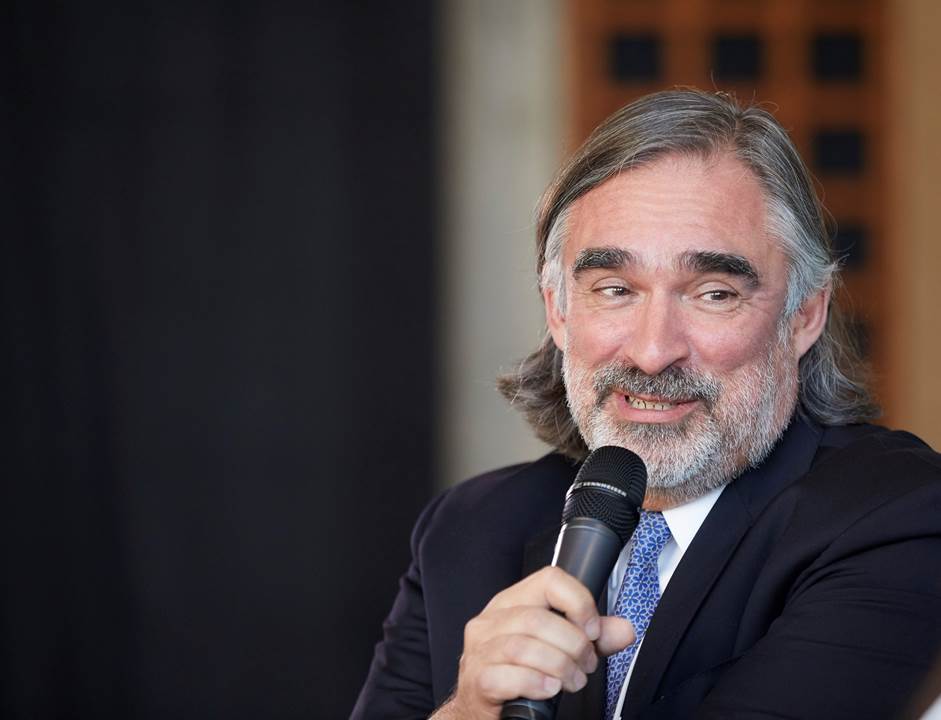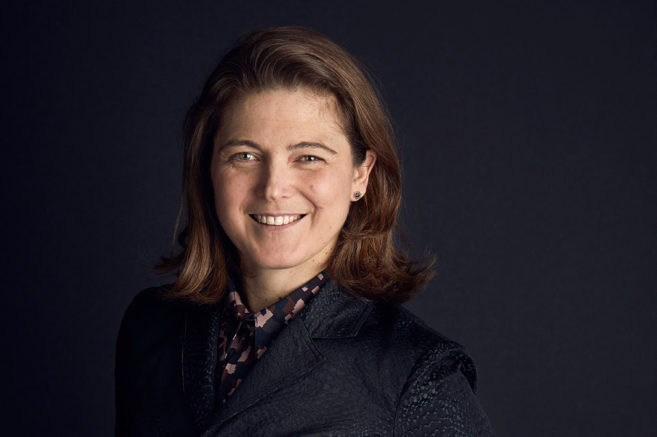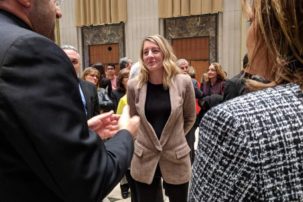Bryne McLaughlin: You have a long institutional history, starting with 49th Parallel in New York in the mid-1980s and then at other major public galleries both in Canada and the US. What are some of the landmark shifts you’ve seen and experienced in the institutional landscape?
Marc Mayer: That’s a tough question. I think the fact that Indigenous art and artists have become one of the centres of our conversation in contemporary art is a big change. That is wonderful. I remember a delegation from Germany that came when I was director of the Musée d’art contemporain de Montréal and wanted to see the contemporary Indigenous art in the collection. This was 14 or 15 years ago. So I went to the curators and said we’ve got a bunch of charming museum people coming in and they want to talk about Indigenous art. Well, they said, we don’t have any. I said, What do you mean we don’t have any?! I was shocked. I talked about it in my director’s foreword for the first Québec Triennial in 2008, saying, where are the Indigenous artists, where are the Haitian artists, what’s wrong with this picture? Why is it so Anglo-Franco? I asked the question frankly in the catalogue for an exhibition that didn’t have those artists in it. That’s changed now. Curators have become much more interested. You’re seeing a lot more contemporary Indigenous art in museums in Quebec than there was 10 years ago, when there was almost none at all.
I was thinking about something the other day that has also changed. We haven’t achieved democracy yet, but as the ideals of democracy have permeated more deeply into our consciousness, with things like individual liberty, et cetera, diversity is a much, much broader subject then just ethnic diversity or diversity of origins. It’s diversity of individual perspectives as well and that’s very challenging for museums to address. Museums can no longer continue to speak with an institutional voice that presumes one kind of listener, someone with the same kind of ethnic, socio-economic and educational background as the curators. Those days are gone, I hope forever.
I was really inspired by the consultations we did with Indigenous art experts for our Canadian and Indigenous Galleries, because I want this to be an Indigenous art national gallery as well, and so that specific audience feels engaged and addressed as much as anybody else who comes in here. We’ve got to ask them, what’s going to make you feel good about coming here? What do you think the people in your community need for this place to be? How do we do this? Their answers kind of blew my mind. Some of these things I’ve never considered, never thought about, that made perfect sense, none of it was odd, all of it was logical, all of it was perfectly understandable and acceptable. I realized we need to be doing this with many different communities in Canada.
So we’ve created the Transcultural Think Tank. It will include experts on contemporary art from various communities in Canada that are underrepresented in the large public institutions, this one notably, and ask, what’s wrong with this picture from your point of view? How can we be more responsive, more attractive and more helpful, really, to the artists in your community, and to your community? We don’t have enough people with the right kind of expertise to do that. We can’t have, what is it, 71 different ethnicities in our collection. But again, I want to make sure that ethnicity is not the only issue when we talk about diversity. We’re talking about sexual diversity and diversity of influences and diversity in perspectives on the world. This is something that’s been very important to me and that I’ve learned a lot from. I’m much more ambitious about it now than I was in the beginning. I’m only sorry that I’m not going to be able to see this through. There may be some sort of public document that comes out of that, I don’t know, but it’s really up to our facilitators to do that.
BM: So the goal of this working group is to start to expand the knowledge base within the institution from the top down?
MM: Yes, exactly. To not only sensitize our curators, but also to give us concrete information. Who are the artists that you think are unbelievable that we haven’t paid attention to? What are the works that have flown past our noses and we didn’t jump on and you’re looking at us like we were nuts to let that one go? So real concrete examples or what we should be doing and who we should be celebrating.
BM: I was also thinking when formulating that opening question about the international presence of Canadian artists and the role public institutions play in creating that kind of visibility. 49th Parallel was in many respects a hallmark of its time: an independent exhibition space for Canadian artists in New York funded by the federal government. That kind of support is long gone, so what is the role of our major public institutions now in creating opportunities for artists at home and abroad?
MM: Yes, well this is something that I know something about, having done that for a living not only in New York but also in Paris. That’s a tough remit, I gotta tell you, just the way the global art world is structured. I did have a great solution for the government. It didn’t go anywhere. But there are ways; there are strategies. I think we’ve improved the way Canada is represented at the Venice Biennale, for example, and building an endowment that is now up to $5 million. The more money in that endowment, the more autonomy we’re going to have in selecting the artists and the more time the artists have for concentrating on making the work. By the time that the whole process that was formerly managed by the Canada Council was done, the call for proposals and going through all of that, there was about nine months left for the artist to actually make some work for the most important show of their career, certainly up to that point for many of them. Now they get more like 20 months and a lot of the fundraising has already been done through sponsorships and we have a great partnership with the Canada Council, which doubled the amount of money put toward the Canadian representation in Venice.
There’s also the Sobey Art Award and our Canadian Biennial, which showcases the best of Canadian art—the things that we actually bought of Canadian art with the things that we actually bought in international art—and showing them together, and [we] have Canadians walking around and they can’t tell which is which, it’s all that good. I’m excited about what we’ve done with contemporary art; that’s closest to my heart of course as a contemporary art person. And I’ve got an over-performing and understaffed contemporary art department. But I think we’ve achieved that youthfulness, I think we have.
BM: I’ve always been curious about the political role of the director of the National Gallery of Canada, which is, after all, a crown corporation. What has your relationship been with government? Is the director a kind of intermediary between the politics of the day happening across the Rideau Canal from the gallery and the cultural mandate of running Canada’s flagship museum? How independent is that relationship?
MM: Well, what people presume is simply not true. The government pretty much leaves us alone. I don’t have monthly, quarterly, even annual conversations about what we’re doing in our programming or in our acquisitions. Having lived it for 10 years, I can assure Canadians the arm’s length thing is real and it’s respected. And when it isn’t, politicians know what the consequences are: the front page of the newspaper. So that’s a nice deterrent. I’ve been very lucky. I mean we have a very different relationship with the current government than we did with the last government. Minister Moore didn’t like one of the shows so he told the press. He didn’t tell us to cancel the show, he simply said the average Canadian is probably going to be shocked. When someone said, is the minister censoring you? I said, no, he’s doing us a public service. He’s telling people if you’re squeamish about sexuality, about certain subject matter in museums, this show is one you might want to sit out. But he didn’t tell us to close it. That would have been interference. That would have been censorship. But they have been the least of our worries.
For me, what I found very challenging is the press using cultural institutions like ours to embarrass government. I lived through a lot of that. That’s kind of between the lines in a lot of the reporting we’ve had for some of the controversies, and there have been a lot. That was something that I had never experienced before. I’ve never really had a problem in media relations with issues that could help sell newspapers and plus makes the government look bad.
BM: On this note of accountability, is the director of the NGC more publicly accountable, particularly in the era of social media?
MM: My social media accounts are very personal. No one has ever complained about why am I not promoting the gallery more. I think that’s because people are happy to see that the director of the National Gallery is actually a human being with specific interests that go beyond art, but when they are in art, they’re good choices. I use social media differently than a lot of my colleagues who see it more as an extension of marketing.
If the job here has changed, it’s because of the way I decided to do it. I wasn’t going to get anywhere far if I didn’t have more money and asking the government for more money was an enormous waste of time, as the government was at pains to remind me, again and again. So I decided to appeal to Canadians directly, those people who have money to buy works of art that we can’t afford and to help promote Canadian art abroad. The job is the job that you give yourself.
My responsibility is really also as a public intellectual, and I’ve done a lot of that. I give a lot of lectures, not only on what we’re doing at the gallery but on the philosophies behind some of the decisions we’ve made. I’ve encouraged the curators to do that as well. I reorganized the reporting structure here so that I could participate much more in the conversations around acquisitions and programming. I’m not the one who chooses, but I am the one who tests and tests and tests because if I believe in it I want to make sure the curator isn’t going to go down in flames when they present this thing to our advisors and our board. So I want to be their collaborator there; if they haven’t been able to sell it to me, chances are they’re not going to be able to sell it to the others. That’s a different approach and I’ve said yes to curators who want to acquire things I didn’t like or wasn’t interested in. I’m reminded daily that it’s not about me, and my curators remind me of that.
Of course the role is different for every museum, but advice I would give another museum director is: don’t be the only one who gets to talk. And be very careful to listen to your curators as much as possible, try not to intimidate them, try to make them feel safe when they are talking to you so they can say crazy things, because in some of those crazy things are the reasons why we should buy this work or do this show that might not have been obvious to you coming in.
So there’s a lot of personality involved in the job. But you do have to be good at fundraising. Once you break the code and realize what fundraising entails, it’s not a boring thing, it’s not awful and the people who are giving you money are going to give it to you because they believe in your cause too, and if they don’t, then you move on to the next person.
BM: You’ve been described as a risk-taker, and have drawn some controversy, for some of the things you’ve said and done. Looking back with 20/20 hindsight, what were the big risks you took at the NGC and were they worth taking?
MM: Oh boy. Well there are risks that I took that I didn’t know were going to be risks. You don’t get anything done if you’re risk averse. In fact, I think that being risk averse is too risky. If you don’t take any risks then you’re going to get yourself in trouble because that’s really what they’re paying you to do, I think, to a large extent.
We were playing it pretty fast and loose with the rehang of the Canadian and Indigenous Galleries and how that got financed, I have to say. That was a nail-biter right to the bitter end. It helped that I had personal relationships with some of the ministers, who consoled me that in all likelihood the Treasury Board was going to approve our request to spend our own money on this very, very good cause. But until they said yes or no, we had no business spending any of that money and if we didn’t start spending it right away we would not have been ready on time for the Canada 150th celebrations. That was scary.
Borrowing certain works of art with staggering insurance values and the conditions that some of the lenders put on it, those are things that keep museum directors up at night because if you don’t get those pictures, no one will come to your show, and if nobody comes to your show, you’re going to have a huge deficit. So we are entrepreneurs. Even the most bookish, the most intellectual aesthete who’s running an art museum, is an entrepreneur with all of the scary stuff attendant with that kind of work. It’s just the nature of this particular beast. And the bigger the museum, the bigger the risk.
BM: What work is left undone? How, for instance, does the NGC’s commitment to Indigenous art continue after Canada 150?
MM: I’m too pooped out to really think about it after 10 years. But I will say that even though our Transcultural Think Tank hasn’t taken place, I’ve radically globalized our collecting at the gallery. When I first got here, my curator of Indigenous art was saying, This is unbelievable, the names of all of the artists that you’re giving me are all names that we’ve proposed before that didn’t get any purchase, so I’m with you 100 per cent. So Josée Drouin-Brisebois [the NGC’s Senior Curator of Contemporary Art] and I always worked together, and we would agree on about 80 per cent of artists and the works that the curators of contemporary art proposed to me. I’d go, Great, I can’t believe you were able to put that on reserve. We’re in competition with MoMA and Tate for these things.
What is yet to do isn’t that we need to internationalize the collection more. We’re already buying art from all over the world. But are we buying the same artists from all over the world that all of the other museums that are buying art from all over the world are buying? So it’s how are we going to empower the Canadian artists, the ones that we’re not looking at because we don’t get it, because they’re not one of the cool kids from your perspective, but they definitely are from someone else’s in the country. That’s the work that has to be done. The research in Canada, I think, needs to be deepened. That’s not to denigrate the work that my curators are doing. Their heart is in the right place, they’re very, very avid and excited about artists they’ve never seen before and they’re behind this project 100 per cent. So that work of getting ahead of the curve of the other museums that have globalized is the work that needs to be done, because we’ve globalized—that part doesn’t need to be done.
BM: Any parting advice for your successor?
MM: Don’t be afraid to make sure the government knows that you need money for this, that and the other thing. And don’t let them trick you by saying it has to be in a proper format and it has to be…be much more present, be much more vocal. I put all of my efforts into the private sector because that work had not been done, and there’s a lot of low-hanging fruit, as they say. And we’ve been very successful, and when you’re successful you keep going in that direction. But there’s just one of me and I think there’s more money in the public sector that can help this institution be much more useful to the whole network of Canadian museums. And I would say be as generous as you can to you colleagues across the country because never forget that the National Gallery of Canada was created for the whole country and not just for one city. That’s super important.

 Marc Mayer in conversation during the 2018 Sobey Art Award artists luncheon at the National Gallery of Canada, November 2018. Courtesy National Gallery of Canada. Photo: Miv Photography.
Marc Mayer in conversation during the 2018 Sobey Art Award artists luncheon at the National Gallery of Canada, November 2018. Courtesy National Gallery of Canada. Photo: Miv Photography.






